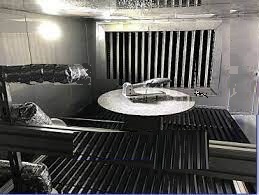
Icing Chamber Kelviron Manufacturers Exporters and Suppliers in India
We at Kelviron Technologies Bangalore are Manufacturers and Suppliers of Icing Chamber. This chamber is as per MIL-STD-810, DEF-STAN 00-35 EN 62271-102. The purpose of this chamber is the Icing and Freezing Rain test which is conducted to evaluate the effect of icing on the operational capability of material. This method also provides tests for evaluating the effectiveness of de-icing equipment and techniques, including prescribed means to be used in the field. We use this method firstly to evaluate material that may be exposed to icing such as produced by rain or freezing drizzle. Secondly, we use this method to develop ice accretion from sea splash or spray but ice thickness may need to be modified to reflect the lower density of the ice. Icing testing reduces the risk of product failure in the field by assessing equipment’s ability to withstand a build-up of surface ice. The test is performed in a climatic chamber and replicates the formation of ice due to freezing rain, or from sea spray and splash. These tests determine performance characteristics for equipment that must operate when exposed to icing conditions that would be encountered under conditions of rapid changes in temperature, altitude and humidity. These procedures specify test methods for evaluating the effects of various icing conditions on the performance or aircraft equipment, namely:
- The effects of external ice or frost adhering to it
- The effects of ice caused by freezing of water condensation or by re-freezing of melted ice
- The effects of ice build-up caused by direct water exposure
RTCA DO-160G provides standard procedures and environmental test criteria for testing airborne equipment for the entire spectrum of aircraft from light general aviation aircraft and helicopters through the “jumbo jets” and SST categories of aircraft. Coordinated with EUROCAE, RTCA DO- 160G and EUROCAE ED-14G are identically worded. RTCA DO-160G is recognized by the International Organization for Standardization (ISO) as de facto international standard ISO-7137. Kelviron Technologies abides by these standards and can customize the chamber according to the client’s requirements. Kelviron Technologies follows few environmental test parameters while conducting the icing test in the climatic chamber, below are the parameters:-
- Rain rate, droplet size, pre-chilled water temperature and temperature- corrected electrical conductivity. Cold floor to simulate frozen ground.
- Fog particle size distribution, fog density and conductivity to match natural observations.
- Uniform temperature from top to bottom of the chamber.
- Uniform wind speed with low turbulence intensity
Specifications of an Icing Chamber are:-
- Temperature is controlled from –10°C to +40°C within 0.2 Co. Near 0°C, rates of change from 0.3 to 30 Co/h is possible. Floor is cooled separately.
- Electric heaters and steam injection allow elevated temperature testing.
- Wind can vary from 0 to 13 km/h using two banks of 16 fans, each with independent speed control. Fans provide stable airflow through the cooling towers (1m w. x 5 m h. zone).
- Twenty-four fixed and 12 oscillating rain nozzles provide uniform coverage with water of controlled temperature and conductivity, for both vertical and horizontal orientations.
- Fixed rain nozzles use time cycling and interchangeable nozzles to establish droplet sizes and rain rate. The super cooling distance is a minimum of 2 m.
- Eight ultrasonic nozzles normally inject 5-10 μm fog particles of controlled conductivity. Fog density exceeding 0.3 g/m3 with 10-15 μm drop size can be set up and maintained for 24 hours.
- Steam can be produced and stored in an external 70-m3 reservoir, and introduced in a rapid and controlled fashion, with minimum stratification using a full-height diffuser. Temperature Control
- Maintaining 94-100% relative humidity and dense fog in freezing temperatures puts unique demands on heat-exchanger design. Incorporating the following essential design features ensures uniform conditions and minimal condensation:
- Two-stage refrigeration system, using glycol for an intermediate coolant
- Heat exchanger surface area of over 400 m2
- Generous spacing of fins to accommodate frosting
- Air flow up to three times the chamber volume per minute through each heat exchanger column Large area heat transfer surfaces and high airflow rates result in less than a 0.01deg C change in temperature each time the air passes through a cooling coil. Very little condensation occurs, even at 99% relative humidity. Cooling coil temperatures typically remain less than 1deg C below ambient, and are excellent indicators of the measured dew point. Chamber Cooling: Embedded “ice-rink” coils and an independent glycol loop in the chamber floor allow it to be cooled independently and maintained at or below the environmental test chamber air temperature. Other auxiliary systems provide rapid venting to the outdoors and heat-tracing to prevent freezing of the rain system, remote-control video cameras, and high intensity lighting. We at Kelviron Technologies manufacture these icing chambers according to client’s requirement.
